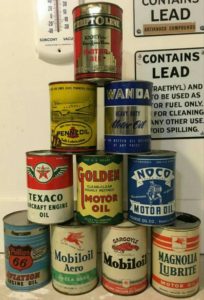
When I envision a new article for I Remember JFK, I am often surprised by the amount of information that is out there for me to research. As regular readers know, I like to ferret out the history of whatever subject I cover. In the case of the bikini, that meant going all the way back to the 4th century! But with today’s entry, the long-lost oil can, I was surprised to find very little on its past, and its subsequent replacement by plastic screw-top containers.
Fortunately, my memory banks are still in good shape. So off we go…
The oil can, as we know, excuse me, knew it, came about in the early twentieth century. It was then that a standard quantity of one quart was sold by most companies. The earliest cans had a solder seam. Collectors prize these oldest examples of oil cans.
By the early 40’s, the soldered seal was gone, replaced with a crimped version. During WWII, when metal was in short supply, oil was sold in cardboard boxes, similar to the milk cartons we drank from in grade school.
After the war, the cardboard oil boxes disappeared. But manufacturers did begin creating the oil can that most of us remember: not really a “can,” per se, but a familiar cylinder made of heavy cardboard. It was cheaper to produce, and proved just as effective as its metal counterparts.
Thus, many a garage in America had, somewhere within its midst, a stack of oil cans. These could be opened with a standard “church key” opener, or, if your dad was prone to splurge money on gadgets, you might have a genuine service station spout, which would pierce the top of the can if shoved in with a bit of force.
Oil cans were a ubiquitous part of our lives, seen everywhere and barely noticed. But in the 1960’s, the oil can’s demise began to be written.

Sometime around the middle of the decade, a plastic cylindrical can was created. It had a metal top, and you opened it exactly like a regular oil can.
But the early plastic cans never really took over the world. It would be the mid eighties before the twist-off cap version of the oil container would appear. It would prove so popular that the oil can would vanish by the end of the decade.
What wasn’t to love? The plastic containers were resealable. They cost next to nothing to produce. And they could be made in any size, allowing you to lug one five-quart jug out of the discount store instead of five individual quarts. You can pour your used oil into the empty container and take it back for recycling.
But another little piece of our past has disappeared. Perhaps we can blame it on Navin Johnson’s tormentor in The Jerk.